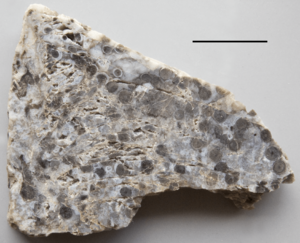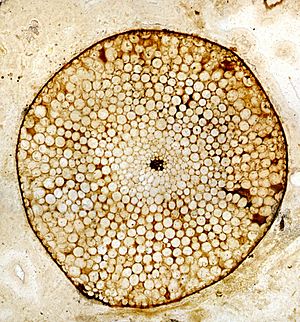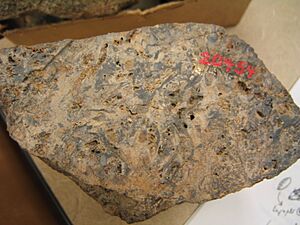Rhynie chert facts for kids


The Rhynie chert is a very old type of rock found in Scotland. It formed during the Devonian period, about 410 million years ago. This rock is special because it holds incredibly detailed fossils, making it a "Lagerstätte" – a place where fossils are unusually well-preserved.
This amazing rock is found near the village of Rhynie in Aberdeenshire, Scotland. Another similar rock, called the Windyfield chert, is located nearby.
The Rhynie chert contains fossils of early plants. These plants had tubes to carry water, but they didn't have true leaves. You can also find arthropods (like ancient insects), lichens, algae, and fungi preserved in this rock.
Contents
Why the Rhynie Chert is Special
The Rhynie chert is famous for two main reasons.
Its Ancient Age
First, the fossils are incredibly old, dating back about 410 million years. This was a very early time in Earth's history when life was just beginning to spread onto land. Studying these fossils helps scientists understand how plants and animals first moved from water to land.
Amazing Fossil Quality
Second, the fossils in the Rhynie chert are preserved in incredible detail. You can often see individual cell walls of plants and even tiny structures like stomata (small pores on plants). Scientists have even found traces of lignin, a substance that makes plant stems strong.
Even more amazing, the book lungs of some early spiders have been seen in cross-sections. This means we can see how their breathing organs looked millions of years ago! Fungal hyphae (tiny threads) can also be seen inside plant material, showing how fungi helped break down dead plants or lived with them.
The oldest known insect fossil, called Rhyniognatha hirsti, was found here. It looks a bit like modern springtails. This discovery pushed back the known origin of insects to an even earlier time, the Silurian period.
How the Rhynie Chert Was Discovered
The Rhynie chert was first found by William Mackie between 1910 and 1913. He was mapping the area around the Rhynie basin.
Since 1980, different groups of scientists have studied the chert. Researchers from Münster and later Aberdeen University helped show that the chert formed because of ancient hot springs. They even drilled deep into the ground in 1988 and 1997 to get more rock samples.
How the Rhynie Chert Formed
The Rhynie chert formed when hot water, full of silica (the main ingredient in glass), came up from volcanic springs. This hot, silica-rich water quickly turned the plants and animals living there into stone. This process is called petrifaction.
Today, hot springs can still petrify organisms, but usually not with such amazing detail. The ancient hot springs at Rhynie were very hot, probably between 90 to 120 degrees Celsius (194 to 248 degrees Fahrenheit). However, the water likely cooled to under 30 degrees Celsius (86 degrees Fahrenheit) before it reached the living things it fossilized.
The rock layers around the chert also show signs of volcanic activity, like layers of sand, shale, and tuff (a type of rock made from volcanic ash). This tells us that the area had active volcanoes. The fossils were covered very quickly, which helped preserve them so well.
The silica in the Rhynie chert looks similar to what you find in freshwater streams at Yellowstone National Park today. These modern springs are usually alkaline (meaning they are not acidic) and warm, around 20 to 28 degrees Celsius (68 to 82 degrees Fahrenheit).
At the time the Rhynie chert formed, about 55% of the land was covered by living plants. Another 30% was covered by dead plant material, and only about 15% of the ground was bare.
Images for kids
See also
 In Spanish: Rhynie Chert para niños
In Spanish: Rhynie Chert para niños



